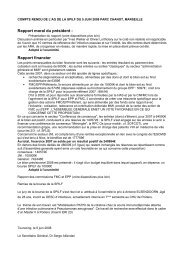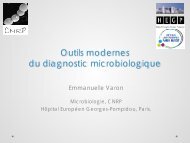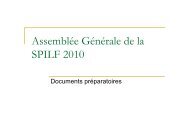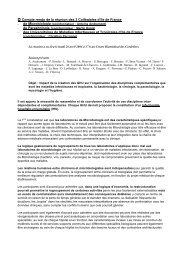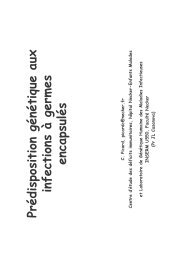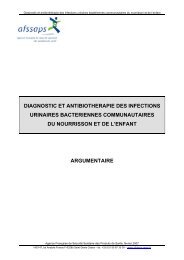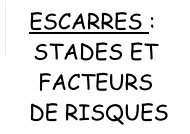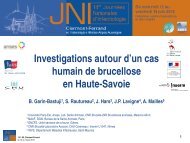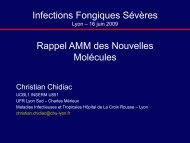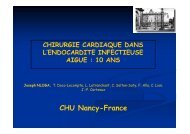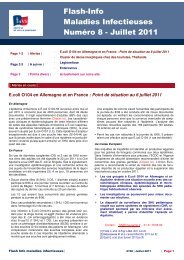Oui : Antoine Cheret - Infectiologie
Oui : Antoine Cheret - Infectiologie
Oui : Antoine Cheret - Infectiologie
Create successful ePaper yourself
Turn your PDF publications into a flip-book with our unique Google optimized e-Paper software.
Faut-il traiter la Primo-Infection<br />
?<br />
Dr <strong>Antoine</strong> Chéret<br />
Laboratoire de Virologie, Hôpital Necker<br />
EA 3620 Université Paris Descartes<br />
Service Universitaire des Maladies Infectieuses CH Tourcoing<br />
1
Lancet infectious disease, 2004<br />
• Transmission est proportionnelle à la charge virale<br />
plasmatique et génitale<br />
• En primo-infection les charges virales plasmatiques<br />
et génitales sont élevées avec un risque de<br />
transmission élevé jusqu’à 26 fois /phase chronique<br />
• Clusters de transmissions<br />
1-Powers KA, rethinking the heterosexual infectivity of HIV-1: a systematic review and<br />
metaanlysis. Lancet infectious disease, 2008<br />
2-Hollingsworth TD, HIV-1 transmission, by stage of infection. J Infect Dis. 2008;<br />
198(5):687-92<br />
3-Brenner BG, High rate of forward transmission events after acute/early HIV-1<br />
infection. J Infect Dis. 2007;195(7):951-9<br />
4-Deirdre Hollingsworth, High Infectivity of Acute HIV Infection amongst Men Who<br />
Have Sex with Men: San Francisco, Croi 2012 poster 552<br />
5-Miller WC, Role of Acute and early HIV infection in the sexual transmissionof Hiv.<br />
Current Opin HIV AIDS 2010;5:277-82<br />
6-Hamlyn E, Antiretroviral treatment of Primary Infection to reduce onward<br />
transmission, Curr Opin HIV AIDS 5:283-290<br />
7-Frange P, Recent HIV-1 infection contributes to the viral diffusion over the French<br />
territory with a recent increasing frequency. PLoS One. 2012;7(2)<br />
2
Myron S. Cohen, Acute HIV-1 Infection, New England Journal of Medecine, May 19, 2011<br />
3
Bénéfices cliniques<br />
-Réduction des symptômes liés au syndrome viral<br />
1-Kassuto S, Longitudinal analysis of clinical markers following antiretroviral therapy iniated during acute or early<br />
HIV type 1 infection. Clin Infect Dis 2006, 42:1042-1043<br />
-<br />
Impact sur les troubles neurocognitifs<br />
2- julia Peterson, changes in Neurocognitive performance from early HIV-1 infection to initiation of ART, Oral abstract 80, Croi<br />
3- T Marcotte, Ealier initiation of ART results in better neurocognitive functionning, Poster 485, Croi 2012<br />
4-Grijsen ML, HIV Medecine 2012, 13, 630-635<br />
4
11<br />
L’inflammation précoce du SNC au cours de la<br />
primo- infection est atténuée par le traitement ARV<br />
Etude en spectroscopie par résonance magnétique du proton<br />
Métabolites cérébraux<br />
(Choline/créatine)<br />
0,5<br />
0,4<br />
0,3<br />
0,2<br />
0,1<br />
Pré-traitement ARV<br />
Pente = 0,000350<br />
p = 0,0070<br />
Post-traitement ARV<br />
Pente= 0,000130<br />
p = 0,0917<br />
n = 26 primo-infections<br />
Date initiation traitement ARV après PI = 28 sem. (12-73)<br />
0<br />
0 100 200 300<br />
Semaines après infection<br />
Young A., CROI 2012, Abs. 79; 1- N<br />
Sailasutra, Brain tCho/Cr is elevated in Acute<br />
HIV within the first Month of Infection, 5 Poster<br />
456, Croi 2012
SPARTAC Trial Design<br />
• Definition of PHI<br />
– Laboratory evidence of infection within 6 months of a<br />
previous negative test,
Time to primary endpoint<br />
Time to primary endpoint SOC ART12 ART48<br />
Median, weeks (95% CI)<br />
Difference vs. SOC<br />
Difference vs. ART12<br />
157 (114,213)<br />
-<br />
-<br />
184 (140,214)<br />
27 (-25,79)<br />
-<br />
222 (189,270)<br />
65 (17,114)<br />
38 (-3,79)<br />
Hazard ratio 95% CI p<br />
ART12 vs. SOC 0.93 0.67 - 1.29 0.67<br />
ART48 vs. SOC 0.63 0.45 - 0.90 0.01<br />
ART48 vs. ART12 0.68 0.48 - 0.96 0.03<br />
Hamlyn E, et al. PLoS One. 2012;7(8):e437548<br />
Fidler et al. IAS, 2011
Essai Primo-SHM : 0, 24 ou 60 semaines de<br />
traitement ARV en primo-infection VIH<br />
Grinjsen, Plos Medicine<br />
9
Essai Primo-SHM : 0, 24 ou 60 semaines de traitement ARV en primo-infection<br />
VIH<br />
Facteurs prédictifs de la (ré)initiation d'un traitement ARV (modèle de Cox<br />
multivarié ajusté sur âge, CD4, résistance et tropisme à baseline)<br />
CV au<br />
setpoint(log10cop/ml)<br />
CD4 au setpoint (log10<br />
CD4/mm3)<br />
HR (IC 95%)<br />
1,69 ( 1,08-2,65) 0,02<br />
0,002 (0,0-0,03) < 0,001<br />
HAART Précoce 0,36 (0,19_0,7) 0,003<br />
P<br />
Le traitement précoce augmente le temps passé sans traitement et réduit<br />
le setpoint virologique<br />
Pas de différence entre 24 semaines et 60 semaines de traitement<br />
Grinjsen, Plos Medicine<br />
10
Physiopathologie et cytokines<br />
Stacey,R; J.Virol, 2008<br />
1-Formes graves : cytokines ( grippe) (Yu, XPLoS One 6:e28680 )<br />
2-Cytokines prédictives du set point viral (Roberts,L Aids 24:819-831)<br />
3-Suractivation lymphocytaire favorise la réplication virale et intervient en favorisant des<br />
mécanismes immunopathologiques délètèrent à terme pour les patients<br />
11
Grande diversité immuno-virologique en Primo-infection<br />
Stocks de cellules<br />
infectées qui<br />
augmente au cours<br />
de la primoinfection<br />
Lewin, S. R. and C.<br />
Rouzioux (2011). AIDS<br />
25(7): 885-897.<br />
Jintanat Ananworanich,<br />
C. Plos Patho 2013<br />
674 patients cohorte primo<br />
Ghosn et al 2010<br />
12
Progression-free survival according<br />
to the baseline HIV DNA level : ANRS Primo Cohort<br />
155 patients, ne recevant pas de TT 36 mois après la primo-infection<br />
A : CD4 à J0 < 628/mm 3 B: CD4 à J0 > 628/mm 3<br />
Proportion > 350 CD4 (%)<br />
100<br />
80<br />
60<br />
HIV DNA < 3.2 (n = 48)<br />
HIV DNA > 3.2 (n = 29)<br />
Proportion > 350 CD4 (%)<br />
100<br />
80<br />
60<br />
HIV DNA < 3.2 (n = 34)<br />
HIV DNA > 3.2 (n = 44)<br />
40<br />
40<br />
20<br />
20<br />
0<br />
Logrank p
CHR<br />
ORLEANS<br />
ADN VIH-1 (Log copies/million de PBMC)<br />
Modélisation des Réservoirs VIH sous traitement en<br />
primo-Infection et en phase chronique<br />
Temps écoulé depuis que l'ARN VIH-1 est indécelable (années)<br />
Cinétique de l’ADN VIH - à18 mois -0.68 versus - 0.43<br />
- de 18 mois à 4 ans -0.22 versus -0.08<br />
- suit un plateau dans les deux groupes<br />
135 Pts Chroniques<br />
22 Pts Primo-Inf.<br />
Hoqueloux et al JAC 2013<br />
1- S.Yerly, AIDS 2000<br />
2-Gianella sara, effect of early antiretroviral therapy during primary HIV-1 infection on cell-associated HIV-1 DNA and plasma HIV-1<br />
RNA,Antiviral Therapy 2011;16:535-545<br />
3-Strain, M. C., S. J. Little, et al. (2005). Effect of treatment, during primary infection, on establishment and clearance of cellular reservoirs of<br />
HIV-1. Journal of infectious diseases 191(9): 1410-1418.<br />
4-Victor von Wyl early antiretroviral therapy during primary HIV-1 infection results in a transient reduction of the viral setpoint upon treatment<br />
interruption, plosone, november 2011<br />
5-Ananworanich et al. PLoS One. 2012;7(3):e33948<br />
Non linear mixed<br />
effects model<br />
14
N=35<br />
N=272<br />
Hocqueloux,<br />
JAC 2013<br />
15
Baseline characteristics :OPTIPRIM<br />
N=90<br />
% Men 92.2<br />
% MSM 75.6<br />
Age a 35.5 (28 - 44)<br />
% Symptomatic 97<br />
Acute stage 43%<br />
HIV-1 RNA log copies/ml a (abbot roche) 5.4 (4.9 - 5.8)<br />
HIV-1 DNA log cp/million PBMC a (technique<br />
ANRS comercialize by Biocentric)<br />
3.6 (3.4 - 4.1)<br />
CD4+ T cell (count /mm 3 ) a 472 (368 - 640)<br />
a<br />
Median, IQR<br />
b<br />
(0 - 1 Ab on western blot at enrolment)<br />
16
Patient disposition - Month 12<br />
• 90 patients randomized and included<br />
• 2 patients drop out (pregnancy, patient decision)<br />
• Tolerance :<br />
‣ well tolerated<br />
‣ 2 Serious adverse effects (both in 3 drugs arm)<br />
• 1 lipodystrophy<br />
• 1 acute pancreatitis<br />
17
300<br />
Immunology: Median change in absolute<br />
CD4+ T cells (/mm3)<br />
p
Immunology: Ratio CD4/CD8 Increase<br />
1.2<br />
19
ARN-VIH1 : OPTIPRIM cp/mL<br />
100<br />
90<br />
80<br />
70<br />
60<br />
50<br />
40<br />
30<br />
20<br />
10<br />
0<br />
M1 M3 M6 M12<br />
≥5000<br />
400≤X
ADN-VIH : OPTIPRIM<br />
HIV-DNA LOG Copies/million PBMCs<br />
5<br />
4<br />
3<br />
2<br />
1<br />
0<br />
J0<br />
M1<br />
M3<br />
M6<br />
M12<br />
N=84 N=79 N=77 N=72 N=65<br />
21
Delta ADN-VIH<br />
22
Buzon,M. CROI 2012
Capacité proliférative et demi-vie des<br />
sous-populations lymphocytaires T CD4<br />
Ag<br />
Éradication<br />
impossible<br />
Capacité proliférative<br />
Naïves TCM TMT TEM effectrices<br />
Durée de vie<br />
Durée<br />
de vie<br />
10 ANS 6-12 mois 3-6 mois 0,6–3 mois 8-15 jours<br />
CXCR4 + + + + +<br />
CCR5 + faible + ++ ++ +++<br />
Victor Appay et al Cytometry, 2008
Réservoir VIH-1 en primo-infection<br />
A<br />
B<br />
C<br />
•Rôle majeur des TCM :<br />
HIV Contrôleurs bas niveau de<br />
réservoir, Saez-Cirion blood 2011<br />
Capacité de renouvellement<br />
Okoye AA J exp Med April 2012<br />
A.chéret, C.Bacchus Ic,<br />
Plosone 2013 Mai<br />
25
Jintanat Anaworanich, oral<br />
abstract 46, CROI 2013<br />
26
•Rôle majeur des TCM :<br />
HIV Contrôleurs bas niveau de réservoir,<br />
Saez-Cirion blood 2011<br />
Capacité de renouvellement Okoye AA J<br />
exp Med April 2012<br />
Jintanat Anaworanich, oral<br />
abstract 46, CROI 2013<br />
27
95 % du réservoir est dans le GUT !<br />
Jintanat Anaworanich, oral abstract 46, CROI 2013
Persistance de l’activation immunitaire chez des<br />
patients traités en fonction du niveau de réservoir<br />
•Traitement en primo diminue activation<br />
•Strain, M. C., S. J. Little, et al. JID 2005 Hocqueloux L, et al Aids 2010 Jun,<br />
Anaworanowich, Plosone 2012<br />
•<br />
Hatano, Hunt, Yukl and Wong (IAS 2011, JID 2013)<br />
1.Yukle, JID 2010<br />
2.Altfeld M, cellular immune responses and viral diversity in individuals treated during acute and early HIV-1 infection. J Exp Med; 2001;193:169-180<br />
3.Dalod M, Weak anti-HIV CD8(+) T-cell effector activity in Hiv primary infection. J Virol.2003;77:6867-6878<br />
4.Lacabaratz-Porret c,impact of antiretroviral therapy and changes in virus load on human immunodeficiency virus (HIV)-specific T cell responses in primary HIV infection. J Infect Dis. 2003;187:748-757<br />
5.Rosenberg ES, Immune control of HIV-1 after early treatment of acute infection. Nature. 2000;407:523-526<br />
6.Bouscarat F,Changes in blood CD8+ lymphocyte activation status and plasma HIV RNA levels during antiretroviral therapy. Aids. 1998;12:1267-1273<br />
7. Hogan C, DeGruttola V, Daar E et al. A finite course of ART during early HIV-1 infection modestly delays need for subsequent ART initiation : ACTG A5217, the SETPOINT Study. 17th Conference on Retroviruses 29 and<br />
Opportunistic Infections. San Francisco USA, Feb 2010. Abstract 134.
Visconti<br />
31
Influence du traitement précoce et long sur l’homéostasie<br />
lymphocytaire et l’homéostasie du réservoir ?<br />
32
OPTIPRIM ANRS047 : un réservoir<br />
bas pour une immunité préservée<br />
BENEFICE IMMUNOLOGIQUE<br />
Préservation des réponses<br />
immunes<br />
Préservation des TCM<br />
BENEFICE sur la transmission<br />
virale<br />
Réplication du VIH<br />
+++<br />
BENEFICE CLINIQUE<br />
AU LONG COURS<br />
ACTIVATION/<br />
INFLAMMATION<br />
Etablissement<br />
RESERVOIRS<br />
Translocation<br />
bactérienne<br />
Destruction<br />
des GALT<br />
33
REMERCIEMENTS<br />
34



